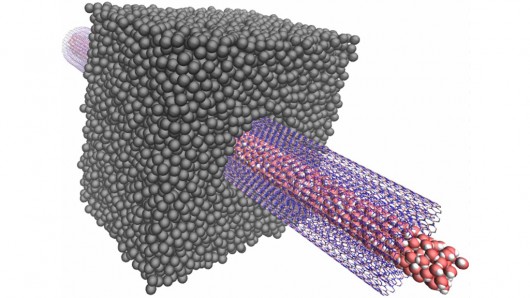Nanotubes boost potential of salinity power as a renewable energy source
By Darren Quick
March 12, 2013

Diagram of the experimental device that sees the osmotic transport of water through a transmembrane boron nitride nanotube (Image: Laurent Joly (ILM))
In November 2009, Norwegian state owned electricity company Statkraft opened the world’s first osmotic power plant prototype, which generates electricity from the difference in the salt concentration between river water and sea water. While osmotic power is a clean, renewable energy source, its commercial use has been limited due to the low generating capacities offered by current technology – the Statkraft plant, for example, has a capacity of about 4 kW. Now researchers have discovered a new way to harness osmotic power that they claim would enable a 1 m2 (10.7 sq. ft.) membrane to have the same 4 kW capacity as the entire Statkraft plant.
The global osmotic, or salinity gradient, power capacity, which is concentrated at the mouths of rivers, is estimated by Statkraft to be in the region of 1,600 to 1,700 TWh annually. Electricity can be generated through the osmotic phenomena that results when a reservoir of fresh water is brought into contact with a reservoir of salt water through the use of a special kind of semipermeable membrane in one of two ways –either by harnessing the osmotic pressure differential between the two reservoirs to drive a turbine, or by using a membrane that only allows the passage of ions to produce an electric current.
The Statkraft prototype plant (and a planned 2 MW pilot facility) relies on the first method, using a polymide membrane that is able to produce 1 W/m2 of membrane. A team led by physicists at the Institut Lumière Matière in Lyon (CNRS / Université Claude Bernard Lyon 1), in collaboration with the Institut Néel (CNRS), have developed an experimental device that they say is 1,000 times more efficient than any previous system, significantly enhancing the commercial viability of osmotic power as a power source.
The team’s experimental device uses the second method. It consists of an impermeable and electrically insulating membrane that was pierced by a single hole through which the researchers inserted a boron nitride nanotube with an external diameter of a few dozen nanometers. With this membrane separating a salt water reservoir and a fresh water reservoir, the team measured the electric current passing through the membrane using two electrodes immersed in the fluid either side of the nanotube.
The results showed the device was able to generate an electric current through the nanotube in the order of a nanoampere. The researchers claim this is 1,000 times the yield of the other known techniques for harvesting osmotic energy and makes boron nitride nanotubes an extremely efficient solution for harvesting the energy of salinity gradients and converting it immediately into usable electrical power.
Extrapolating their results to a larger scale, they claim a 1 m2 boron nanotube membrane should have a capacity of around 4 kW and be capable of generating up to 30 mWh per year, which is three orders of magnitude greater than that of current prototype osmotic power plants.
The researchers’ next step will be to study the production of membranes made of boron nitride nanotubes and test the performance of nanotubes made from other materials.
The research is detailed in a study published in the journal Nature.
Source: CNRS (Délégation Paris Michel-Ange)
Copyright © gizmag 2003 - 2013 To subscribe or visit go to: http://www.gizmag.com
http://www.gizmag.com/osmotic-salinity-gradient-power-nanotubes/26623/